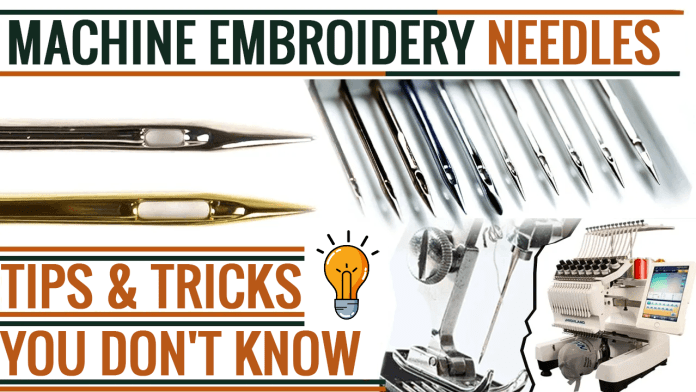Introduction
Machine embroidery is a fascinating and creative art form that allows individuals to personalize various fabrics with intricate designs. However, to achieve stunning embroidery results, it is essential to understand the significance of machine embroidery needles. Often overlooked, the needle is a critical component of the embroidery process. In this blog, we will delve into some valuable tips and tricks related to machine embroidery needles that can significantly enhance your embroidery projects. Whether you’re a novice or an experienced embroiderer, these insights will help you master the art of machine embroidery.
1. Know Your Needle Types
Machine embroidery needles come in various types, each designed for specific fabrics and projects. The most common types are:
a) Universal Needles: Ideal for general-purpose embroidery, these needles work well with woven and knit fabrics for Embroidery digitizing.
b) Ballpoint Needles: Specifically designed for knit fabrics to prevent snags and runs while maintaining smooth stitches.
c) Sharp Needles: Best suited for tightly woven fabrics like silk or satin, offering precise embroidery.
d) Titanium Needles: Durable and long-lasting, these needles have a titanium coating that makes them less prone to breakage.
e) Metallic Needles: Crafted for metallic threads, these needles have a larger eye, reducing friction and preventing thread breakage.
f) Topstitch Needles: Perfect for embroidery designs with many thread changes, as they have a larger eye to accommodate thicker threads for digitizing services.
Choosing the right needle for your project can greatly impact the embroidery’s quality and the lifespan of your machine.
2. The Importance of Needle Size
Needle size is another critical aspect of machine embroidery that deserves attention. Needle sizes are denoted by two numbers: the European metric size (ranging from 60 to 120) and the American size (ranging from 8 to 19). The lower the number, the finer the needle, and vice versa.
When selecting a needle size, consider the fabric’s weight and density, as well as the thread thickness. For lightweight fabrics, opt for finer needles, while heavier fabrics require larger-sized needles to prevent damage.
3. Replace Needles Regularly
One of the most overlooked aspects of machine embroidery is needle replacement. Needles should be changed after every 8 to 10 hours of stitching or after completing a large project. Dull or damaged needles can cause thread breakage, skipped stitches, and even damage to your fabric or machine. Regularly changing needles will ensure smooth and flawless embroidery results.
4. Match Needle Type and Thread
Using the appropriate needle type for the thread you’re using is crucial for a successful embroidery project. If you’re working with metallic threads, use metallic needles with a larger eye to accommodate the delicate thread. Similarly, for embroidery with specialty threads like rayon or polyester, choose needles that won’t cause friction or shredding.
5. Insert Needles Correctly
Proper needle insertion is often underestimated, but it can significantly affect the quality of your embroidery. Always ensure the flat side of the needle faces the back of your machine. Insert the needle all the way up into the needle holder, tightening it securely. An incorrectly inserted needle can lead to alignment issues and compromised stitch quality.
6. Test Before Embroidering
Before starting a big embroidery project, it’s essential to perform a test stitch on a scrap fabric. This allows you to check if the needle type and size, thread tension, and design settings are appropriate for your specific project. Additionally, test stitching helps identify potential issues before they ruin your actual workpiece.
7. Mind Your Speed
Embroidering at excessively high speeds can put undue stress on the needle and fabric, leading to thread breakage and uneven stitching. Gradually increase the machine’s speed to find the optimal pace that ensures smooth and even stitches. Avoid rushing through your embroidery projects to achieve the best results.
8. Use Stabilizers Wisely
Stabilizers are vital in machine embroidery, as they provide support and prevent puckering or distortion of the fabric. Match the stabilizer type and weight with your fabric to achieve the desired results. For example, tear-away stabilizers work well with lightweight fabrics, while cut-away stabilizers are better suited for heavyweight fabrics. Water-soluble stabilizers are ideal for delicate fabrics or when you need the backing to disappear entirely.
9. Monitor Thread Tension
Correct thread tension is crucial for achieving clean and even stitches. Too loose or too tight thread tension can lead to uneven embroidery, thread breaks, or puckering. Experiment with the thread tension settings on scrap fabric until you find the perfect balance for your specific project.
10. Clean and Maintain Your Machine
Proper maintenance of your embroidery machine, including regular cleaning, oiling, and changing needles, will significantly enhance its performance and extend its lifespan. Dust, lint, and debris can accumulate in the machine, affecting the needle’s movement and stitch quality. Always refer to your machine’s manual for specific cleaning and maintenance instructions.
Conclusion
Machine embroidery is a captivating and rewarding craft, and mastering the art of needle selection is an integral part of achieving exceptional results. By understanding the different types of needles, selecting the appropriate size, and following these valuable tips and tricks, you can elevate your machine Embroidery digitizing services projects to new heights. Remember, attention to detail, regular needle replacement, and proper machine maintenance are key factors in creating stunning embroidered masterpieces. So, don’t hesitate to experiment, practice, and perfect your machine embroidery skills by using the right needles for your creations! Happy embroidering!
